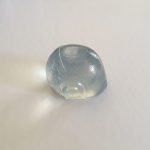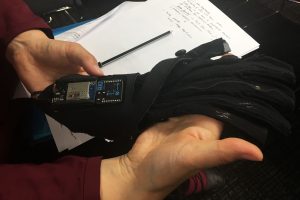When I applied to the Visiting Fellowship of the Centre for Digital Cultures and Innovation, I was already in Brighton, in residency with the interactive art group Blast Theory. Within those two-months at 20 Wellington Road, I started writing and making the very first experimentations of the work.
The conceptual environment I wanted to anchor Wild Diplomacy in was an exploration of how in a context of profound transformation, the world evolves and takes shape in a strong and complex relationship between Man, living and non-living. The first question brought others: what relationships are we developing with other species, the natural elements, AI? How can these forms of life or existence feed imaginations, build stories, inspire processes? My idea was to work on an interactive fiction around representations of natural elements as if they had legal status. In recent decades, some ecosystems have been recognised as ‘people’ in many countries around the world. A radical shift concerning nature’s right to exist for itself.
After the residency, the work took the form of an interactive journey, an in situ experience with the audience in nature, developed with immersive technology and ‘mirror helmets’, imagining that the public could reflect the nature.
I have described the residency in Blast Theory’s blog.
The idea of continuing the Wild Diplomacy project as part of the Visiting Fellowship had met several motivations.
Creating an interactive journey in nature has definitely anchored the project in Brighton’s area, where the interactions between art and the environment are numerous and important. The issues carried by my research closely touch on many of the works and experiments led by the Centre for Digital Cultures and Innovation and more broadly at the University of Brighton. The interdisciplinary approach proposed in the CDCI and the articulation between this centre and others, as well as, groups within the University, was a unique opportunity for me to develop my artistic practice-based research, in an experimental, open and collaborative perspective. Furthermore, my residency was hosted by both the Centre for Digital Cultures and Innovation and the Centre for Spatial, Environmental and Cultural Politics.
University of Brighton – Edward Street
At the SECP, I had the chance to meet two researchers working in issues close to my project, in different disciplines: Matthew Adams and Rachel White
My practice of interdsiciplinarity was until then limited to disciplines around art, design, architecture and digital studies. Discussing, exchanging with researchers in psychology and biology was new for me and has opened a rainbow of horizons, approaches, experimentations very inspiring for my work.
I’ve also had the opportunity to participate to two sessions of System Change HIVE, invited by Julie Doyle and to take part to the conversations and discover the processes the group is setting up.
Some of these decisive meetings were made possible thanks to the sharp, transversal perspective of Stuart Hedley, from the Creative Futures group.
On the side of the CDCI, my fellowship was hosted by Helen Kennedy and Donna Close. Their experience and expertise in VR and immersive technologies were crucial for the step of development of my work in Brighton. As my first idea was to work with VR in this project, I needed to experiment with different types of headsets. During the residency with Blast Theory, I explored lots of VR works and I finally decided not to imagine a virtual world but to develop another kind of perception of nature.
I worked closely with Marley Cole and Rafael Lino in order to research the potential of different technologies. Marley introduced me to the binaural audio and with Rafael I was able to experiment the HTC Vive helmet.
Following the tests, I realized that the collective experience I wanted to create was complicated by VR, and decided to use the binaural sound, that allows me both to put the audience in a strong connection with nature and to build a collective situation.
The other facet of my Fellowship at the CDCI was to produce the first prototype of the ‘mirror helmet’ I wanted to make as part of the interactive journey in the nature. I was able to print with a 3D printer two helmets in a small scale with different materials (resin, PLA, mirror film). This stage was very important and let me design the process to print the helmets in the 1:1 scale.

 First prototype of the helmets, printed with a 3D printer in a small scale
First prototype of the helmets, printed with a 3D printer in a small scale
As part of the Fellowship, I also wanted to engage with the Centre’s community of PhD students.
This community was very interesting because the students have different backgrounds, from geography to photography.
I ran a workshop with them, around speculative fictions related to my work. Under the title 2051: what if natural elements had legal status, the idea was to imagine our relationship to the natural elements in 2051. Why 2051? 2050 being a pivotal date in studies and prognoses on climate change, it seemed interesting to me to place the context one year later.
How can we imagine a forest, a river, a cliff communicating, expressing oneself, in a relationship with humans where these elements would be their equals? How to feel, translate, make visible? Is it possible in our ‘Western approach’ to consider legal representation as in some countries now? Or should we rather stay in a world where ‘exchange and diplomatic relations’ could be the rule?
Taking as a starting point this context and the interdisciplinarity of their respective research, they worked on these speculative fictions by using collage and video as the way to make their stories.
The workshop was organized by Frauke Behrendt as well as the talk I ran at the end of my Fellowship, to discuss the process I engaged in with this work.
I was able to attend Change for the Machine: An XR Symposium, held by Helen Kennedy, Donna Close and Daniel Harley at the end of May.
The form of this project is new in my artistic practice. I was able to develop this first part and link it to my work through the residency with Blast Theory and the Visiting Fellowship at the University of Brighton. The work I deployed in this framework allowed me to create an experience where technology is erased in the narrative, and makes it possible to connect the natural space to the narrative, in a relationship that is both individual and collective.
 Symposium: Change for the Machine
Symposium: Change for the Machine
To follow the progress of Wild Diplomacy, visit my website www.marinaestelawainer.com












Leave a Reply